The 5th Shanghai Biennal: Techniques of the Visible
Location: Shanghai Art Museum, Shanghai
Duration: Sep. 29 – Nov. 28, 2004

The 5th Shanghai Biennal: Techniques of the Visible
Duration: Sep 29th to Nov 28th, 2004
Location: Shanghai Art Museum
The Shanghai Art Museum has announced the Shanghai Biennale 2004, its subject and the curatorial team. Organized by the Shanghai Art Museum, the Shanghai Biennale will be open the 28th of September 2004 and it will run until the 28th of November. The Biennale will take place as in previous years, at the Shanghai Art Museum, and it will be this year extended to other venues.
Continuing this commitment to contemporary artistic practice, the theme of the 2004 Shanghai Biennale, Ying Xiang Sheng Cun, “Techniques of the Visible”, will focus on the close relationship between art, science, and technology, in particular how art has revealed the interdependent social and political forces that produce and subject technology and humanity. Taken from the ancient Chinese terminology of ying and xiang, the concept emerges from an interest in the visual products of modern technology that retain critical historical and emotive references. Ying Xian Sheng Cun suggests that artistic practice engaging with ‘technology’ is inherently placing itself within a historical continuum, where cultural metaphor becomes critical to its understanding.
This year’s Biennale will be curated by Xu Jiang, President, China Academy of Art (China), Zheng Shengtian, Independent Curator (Canada), Sebastián López, Director, Gate Foundation (Netherlands), and Zhang Qing, Director, Shanghai Biennale’s Office (China). Bringing film, photography, video, installation and performance together, the curators will focus on the diversity contemporary practice from Asia, South America, Africa, Europe and North America. The Biennale will draw crucial relations between contemporary art and historical precedents, revealing the interconnected and interdependent nature of art that engages technology. Reiterating the diversity of artists participating, the Biennale is committed to also showcasing a range of contemporary media including painting, sculpture and photography, interactive technologies, video and digital art, and performance. To critically engage the theme of the Biennale, a symposium will also be held, bringing together contemporary artists, curators and theorists.
Large exhibitions such as the Biennale provide not only an important moment for the display of contemporary art production, but are also forums where artists can meet, challenge their own work and expand their experience. In addition, the Biennale provides the opportunity for a truly international exchange of ideas. Bringing together artists, curators, writers, theorists and art supporters from around the world, the Biennale presents a critical space of dialogue within an increasingly global art market. The presence of the Biennale in Shanghai only foregrounds the increasingly important role of artistic production in the Asia-Pacific region.
“Long March Project – The Great Survey of Paper-cutting in Yanchuan County”
25000 Cultural Transmission Center and the Yanchuan County Government
The “Long March Project – The Grand Survey of Yanchuan County Paper-cuttings” is a special entry in this year’s Biennale. At the same time it is also an important part of the series of Long March projects designed and carried out by “The Long March – A Walking Visual Display.” The project takes contemporary art as its departure point, combining with it the methods of anthropology and social research. One county is used as the basic unit in which to carryout a thorough field investigation and in-depth analysis of case studies and samples collected to examine the existing condition of “folk art,” as well as to create a powerful and complex visual display at the Shanghai Biennale – in a conventional and institutional contemporary art space. The project touches upon different levels of the contemporary Chinese social and organizational structure; breaking the inner borders of contemporary visual culture in China, and constructing a meaningful and profound link between the two macro-systems of “folk art” and contemporary art, and the areas of metropolitan Shanghai and inland Yanchuan County. At the same time, the “Grand Survey of Yanchuan County Paper-cuttings” uses paper-cutting art as an example to represent the “folk/public,” thereby questioning the ongoing institutionalization of “contemporary art.” If the modern concept of an “art work” emphasizes an individualized author, then should the author of “The Grand Survey of Yanchuan County Paper-cuttings” be the Long March Foundation, the 25000 Cultural Transmission Center, the Yanchuan County government, the authors of the 15,000 paper-cutting works collected by the survey, or the 180,000 people of Yanchuan County who were surveyed? Whereas before, the huge “invisible” masses of inland China and “contemporary art” were mutually disconnected from one another, through eight months of arduous fieldwork, “The Grand Survey of Yanchuan County Paper-cuttings” has extended the site of the Shanghai Biennale (and of the “contemporary”) into this completely unfamiliar realm.
Conceptual Diagram

Exhibition Site
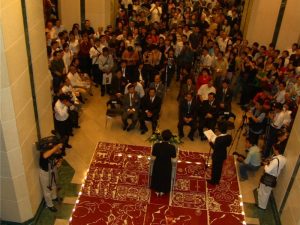
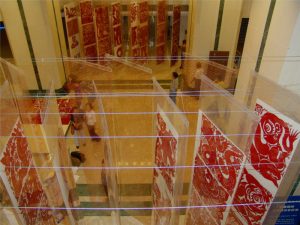
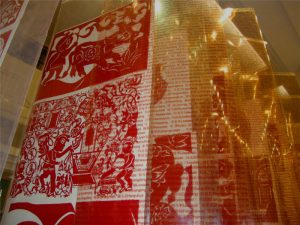
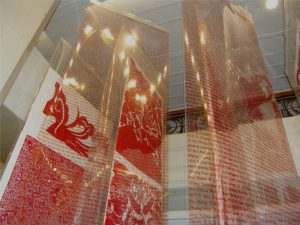

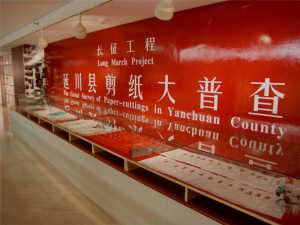

Li Tianbing at Shanghai Biennial
Li Tianbing fell in love with photography when he was a teenager back in the 1940s. He stole a cow from his family and walked for three days until he arrived in the city, where he bartered the cow for a UK-made camera. Ever since that day, he has been taking pictures for residents in neighboring villages, using that same old camera. Wedding days, political movements, graduation ceremonies, changes brought along by reform, folk customs and traditions are all subjects of Li’s photography. He is a legendary figure amongst villagers who sing songs about him. The mountainous area in Fujian where he lives lacks electricity. Because of this, Li develops and enlarges his photographs with light from the sky that filters down his chimney. In addition, his cow barn also serves as a dark room. He opens the wooden door of the barn and exposes his pictures with the light coming through the surrounding bamboo jungle. His calculation of exposures is so precise that it happens within 1/2 second. Li has taken more than 300,000 photographs using this method and upholds a Guinness record in “taking the largest number of photographs with natural lights and resources.” Li arrived in Ruijin to join the Art Long March. He photographed the first site of the Long March and held his solo exhibition in the former Soviet Post and Telecommunication Ministry.
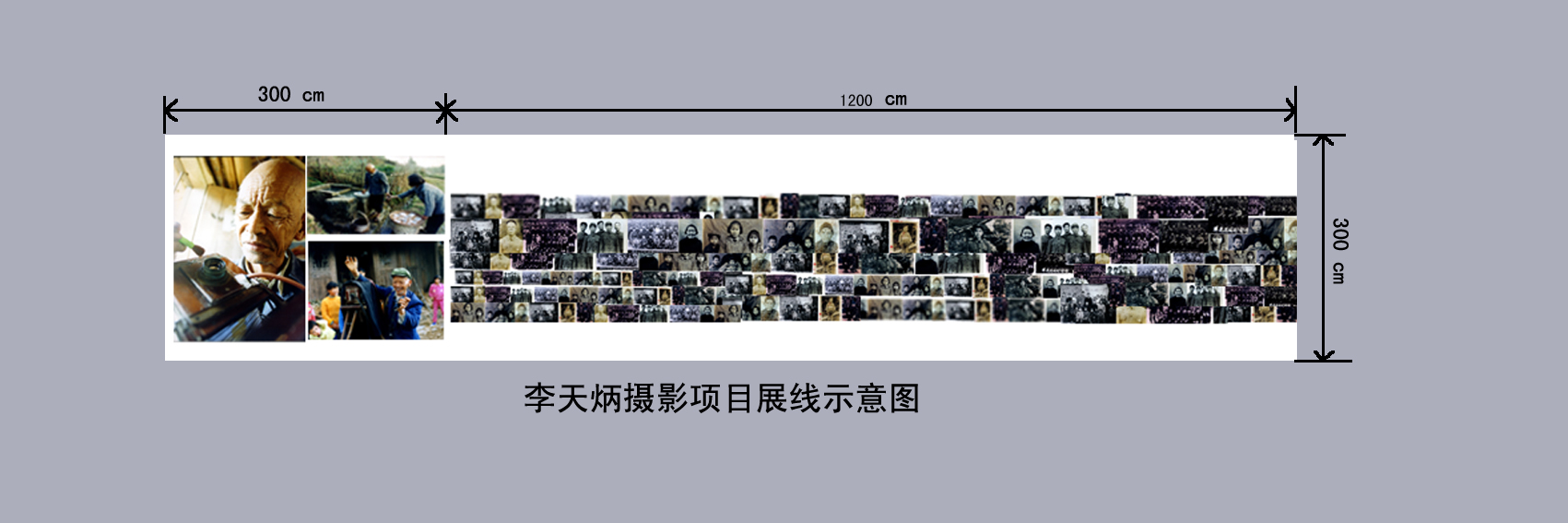
The 5th Shanghai Biennal: Techniques of the Visible
Duration: Sep 29th to Nov 28th, 2004
Location: Shanghai Art Museum
The Shanghai Art Museum has announced the Shanghai Biennale 2004, its subject and the curatorial team. Organized by the Shanghai Art Museum, the Shanghai Biennale will be open the 28th of September 2004 and it will run until the 28th of November. The Biennale will take place as in previous years, at the Shanghai Art Museum, and it will be this year extended to other venues.
Continuing this commitment to contemporary artistic practice, the theme of the 2004 Shanghai Biennale, Ying Xiang Sheng Cun, “Techniques of the Visible”, will focus on the close relationship between art, science, and technology, in particular how art has revealed the interdependent social and political forces that produce and subject technology and humanity. Taken from the ancient Chinese terminology of ying and xiang, the concept emerges from an interest in the visual products of modern technology that retain critical historical and emotive references. Ying Xian Sheng Cun suggests that artistic practice engaging with ‘technology’ is inherently placing itself within a historical continuum, where cultural metaphor becomes critical to its understanding.
This year’s Biennale will be curated by Xu Jiang, President, China Academy of Art (China), Zheng Shengtian, Independent Curator (Canada), Sebastián López, Director, Gate Foundation (Netherlands), and Zhang Qing, Director, Shanghai Biennale’s Office (China). Bringing film, photography, video, installation and performance together, the curators will focus on the diversity contemporary practice from Asia, South America, Africa, Europe and North America. The Biennale will draw crucial relations between contemporary art and historical precedents, revealing the interconnected and interdependent nature of art that engages technology. Reiterating the diversity of artists participating, the Biennale is committed to also showcasing a range of contemporary media including painting, sculpture and photography, interactive technologies, video and digital art, and performance. To critically engage the theme of the Biennale, a symposium will also be held, bringing together contemporary artists, curators and theorists.
Large exhibitions such as the Biennale provide not only an important moment for the display of contemporary art production, but are also forums where artists can meet, challenge their own work and expand their experience. In addition, the Biennale provides the opportunity for a truly international exchange of ideas. Bringing together artists, curators, writers, theorists and art supporters from around the world, the Biennale presents a critical space of dialogue within an increasingly global art market. The presence of the Biennale in Shanghai only foregrounds the increasingly important role of artistic production in the Asia-Pacific region.
“Long March Project – The Great Survey of Paper-cutting in Yanchuan County”
25000 Cultural Transmission Center and the Yanchuan County Government
The “Long March Project – The Grand Survey of Yanchuan County Paper-cuttings” is a special entry in this year’s Biennale. At the same time it is also an important part of the series of Long March projects designed and carried out by “The Long March – A Walking Visual Display.” The project takes contemporary art as its departure point, combining with it the methods of anthropology and social research. One county is used as the basic unit in which to carryout a thorough field investigation and in-depth analysis of case studies and samples collected to examine the existing condition of “folk art,” as well as to create a powerful and complex visual display at the Shanghai Biennale – in a conventional and institutional contemporary art space. The project touches upon different levels of the contemporary Chinese social and organizational structure; breaking the inner borders of contemporary visual culture in China, and constructing a meaningful and profound link between the two macro-systems of “folk art” and contemporary art, and the areas of metropolitan Shanghai and inland Yanchuan County. At the same time, the “Grand Survey of Yanchuan County Paper-cuttings” uses paper-cutting art as an example to represent the “folk/public,” thereby questioning the ongoing institutionalization of “contemporary art.” If the modern concept of an “art work” emphasizes an individualized author, then should the author of “The Grand Survey of Yanchuan County Paper-cuttings” be the Long March Foundation, the 25000 Cultural Transmission Center, the Yanchuan County government, the authors of the 15,000 paper-cutting works collected by the survey, or the 180,000 people of Yanchuan County who were surveyed? Whereas before, the huge “invisible” masses of inland China and “contemporary art” were mutually disconnected from one another, through eight months of arduous fieldwork, “The Grand Survey of Yanchuan County Paper-cuttings” has extended the site of the Shanghai Biennale (and of the “contemporary”) into this completely unfamiliar realm.
Conceptual Diagram

Exhibition Site








Li Tianbing at Shanghai Biennial
Li Tianbing fell in love with photography when he was a teenager back in the 1940s. He stole a cow from his family and walked for three days until he arrived in the city, where he bartered the cow for a UK-made camera. Ever since that day, he has been taking pictures for residents in neighboring villages, using that same old camera. Wedding days, political movements, graduation ceremonies, changes brought along by reform, folk customs and traditions are all subjects of Li’s photography. He is a legendary figure amongst villagers who sing songs about him. The mountainous area in Fujian where he lives lacks electricity. Because of this, Li develops and enlarges his photographs with light from the sky that filters down his chimney. In addition, his cow barn also serves as a dark room. He opens the wooden door of the barn and exposes his pictures with the light coming through the surrounding bamboo jungle. His calculation of exposures is so precise that it happens within 1/2 second. Li has taken more than 300,000 photographs using this method and upholds a Guinness record in “taking the largest number of photographs with natural lights and resources.” Li arrived in Ruijin to join the Art Long March. He photographed the first site of the Long March and held his solo exhibition in the former Soviet Post and Telecommunication Ministry.
